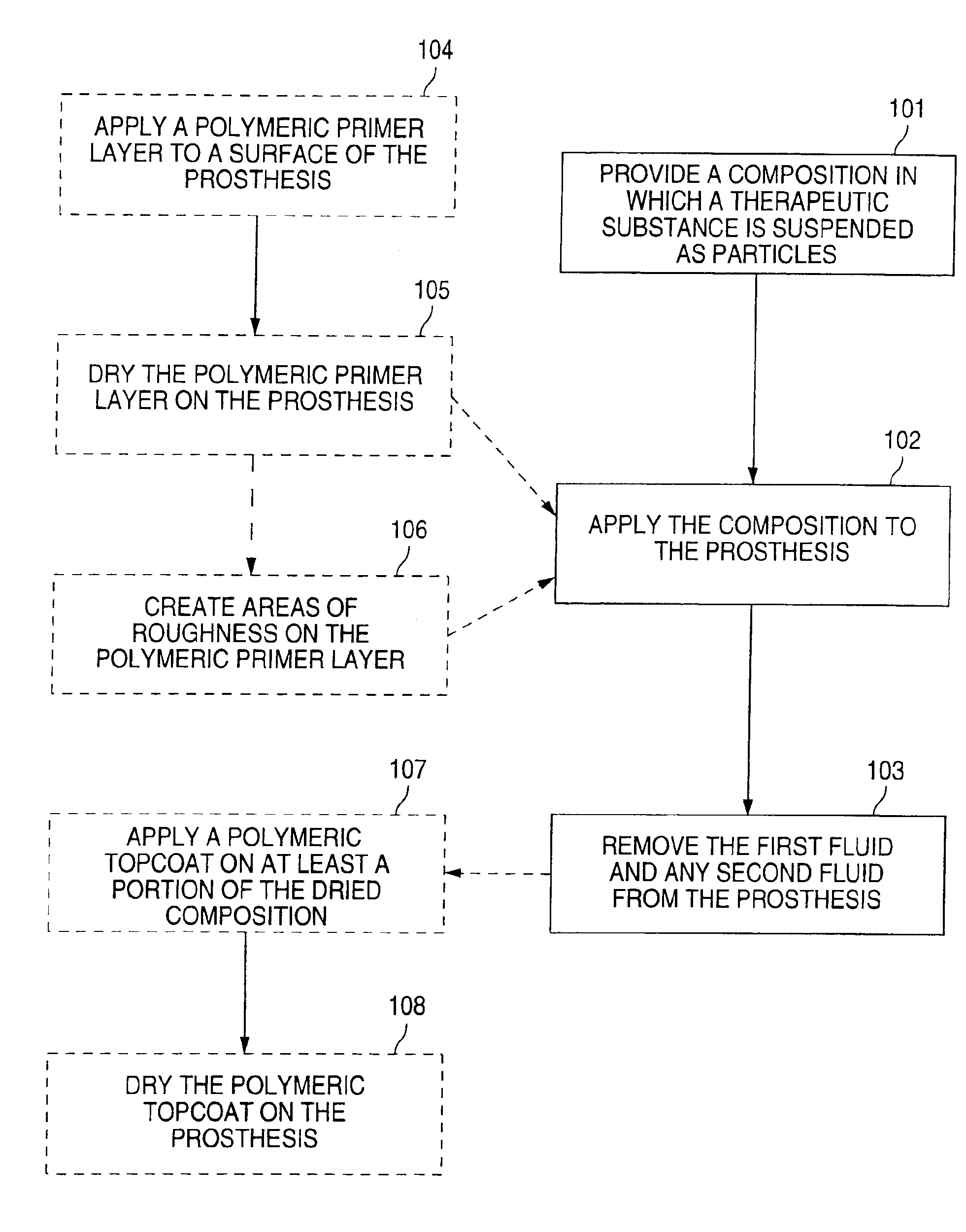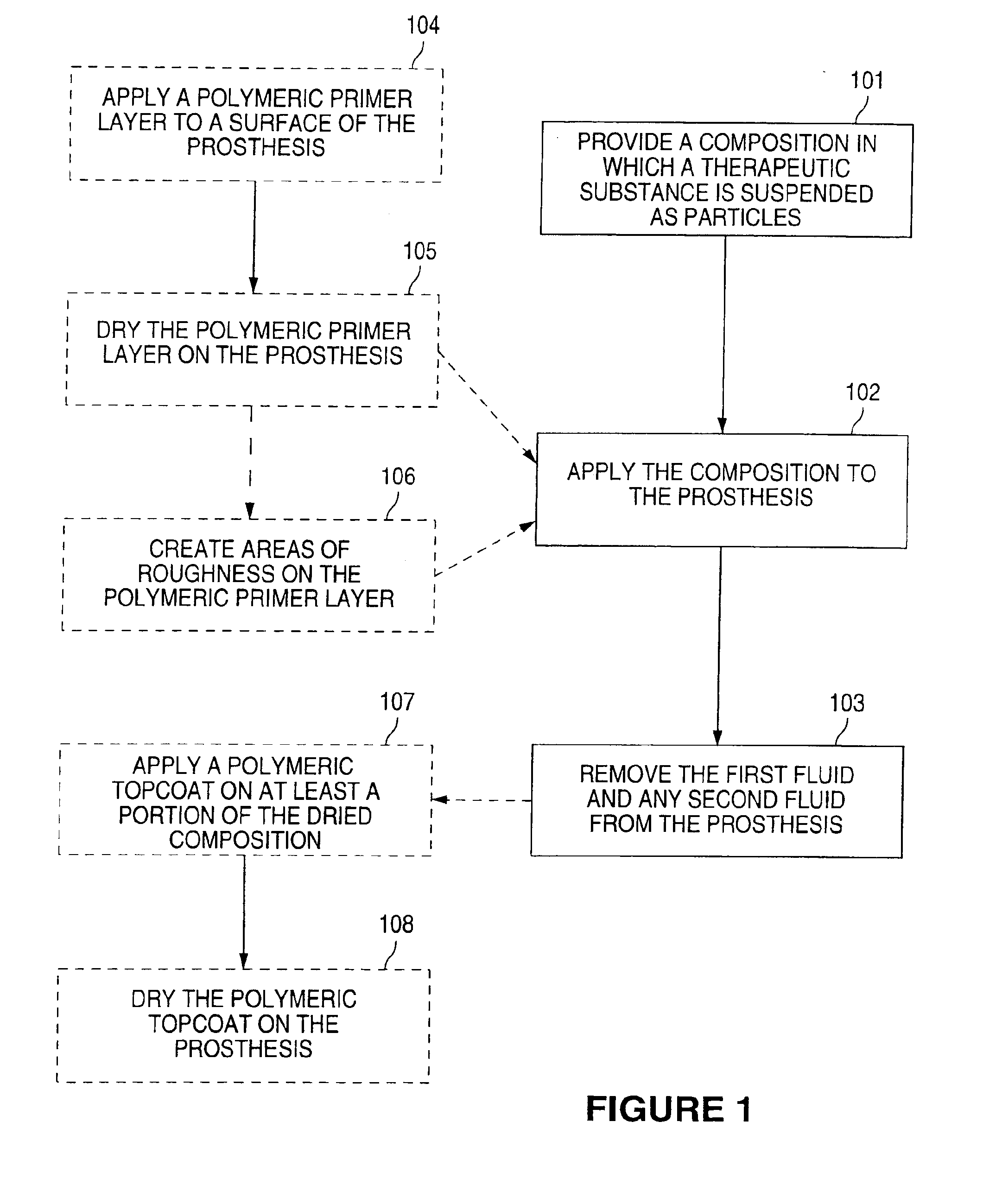Composition for coating an implantable prosthesis
a prosthesis and implantable technology, applied in the field of implantable devices, can solve the problems of affecting the treatment effect of patients, so as to reduce the flocculation of the therapeutic substance and limit the solubility
- Summary
- Abstract
- Description
- Claims
- Application Information
AI Technical Summary
Benefits of technology
Problems solved by technology
Method used
Image
Examples
example 1
[0045]The following is an exemplary method in which the composition includes a therapeutic substance and a first fluid. A polymeric primer layer and a polymeric topcoat are also employed.
[0046]Multi-Link Duet™ stents (available from Guidant Corporation) are cleaned by placement in an ultrasonic bath of isopropyl alcohol solution for 10 minutes. The stents are air-dried. A primer coating of ethylene vinyl alcohol copolymer (EVOH) is made with 1 gram of EVOH and 5 grams of dimethyl sulfoxide (DMSO), yielding an EVOH:DMSO ratio of 1:5. The EVOH is dissolved by placing the vial of EVOH:DMSO solution on a roller bottle apparatus in an oven at 60° C. for 6 hours. The EVOH:DMSO solution is sprayed onto the cleaned Multi-Link Duet™ stents. The primer-coated stents are placed in an oven at 60° C. for 4 hours.
[0047]A 5% suspension of actinomycin D is made by adding 0.05 gram of actinomycin D to 1 gram of methanol. The primer-coated stents are dipped into the suspension for 5 seconds. The acti...
example 2
[0049]The following is another exemplary method in which the composition includes a therapeutic substance and a first fluid. A polymeric primer layer and a polymeric topcoat are also employed.
[0050]Multi-Link Duet™ stents are cleaned by placement in an ultrasonic bath of isopropyl alcohol solution for 10 minutes. The stents are air-dried. A primer coating of EVOH is made with 1 gram of EVOH and 7 grams of DMSO, yielding an EVOH:DMSO ratio of 1:7. The EVOH is dissolved by placing the vial of EVOH:DMSO solution on a roller bottle apparatus in an oven at 60° C. for 6 hours. The EVOH:DMSO solution is applied to the cleaned Multi-Link Duet™ stents by a modified dip method. The primer-coated stents are placed in an oven at 60° C. for 4 hours.
[0051]A 5% suspension of actinomycin D is made by adding 0.05 gram of actinomycin D to 1 gram of methanol. The primer-coated stents are dipped into the suspension for 5 seconds. The actinomycin D-coated stents are then air-dried for 15 minutes.
[0052]A...
example 3
[0053]The following is an exemplary method in which the composition includes a therapeutic substance, a first fluid, a polymer, and a suspension stabilizer.
[0054]A Multi-Link Duet™ stent is cleaned by placement in an ultrasonic bath of isopropyl alcohol solution for 10 minutes. The stent is air-dried. An EVOH:DMSO solution is made with 1 gram of EVOH and 4 grams of DMSO, making a solution having a EVOH:DMSO ratio of 1:4. Actinomycin D is added to the EVOH:DMSO solution to form a suspension. Actinomycin D constitutes 10% by weight of the total weight of the suspension. Pluronic, a suspension stabilizer, is added to the suspension to slow the flocculation rate of the suspended actinomycin D particles. The suspension stabilizer constitutes 0.5% by weight of the total weight of the suspension. The suspension is vortexed for 10 seconds. The viscosity of the EVOH:DMSO solution is adequate to slow the flocculation rate of the suspended actinomycin D particles for approximately 30 minutes. ...
PUM
| Property | Measurement | Unit |
|---|---|---|
| Fraction | aaaaa | aaaaa |
| Fraction | aaaaa | aaaaa |
| Fraction | aaaaa | aaaaa |
Abstract
Description
Claims
Application Information
 Login to View More
Login to View More - R&D
- Intellectual Property
- Life Sciences
- Materials
- Tech Scout
- Unparalleled Data Quality
- Higher Quality Content
- 60% Fewer Hallucinations
Browse by: Latest US Patents, China's latest patents, Technical Efficacy Thesaurus, Application Domain, Technology Topic, Popular Technical Reports.
© 2025 PatSnap. All rights reserved.Legal|Privacy policy|Modern Slavery Act Transparency Statement|Sitemap|About US| Contact US: help@patsnap.com


